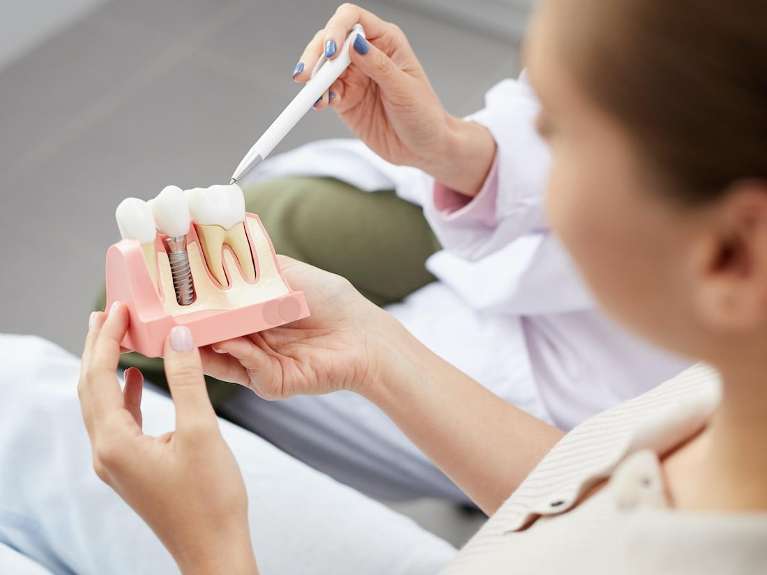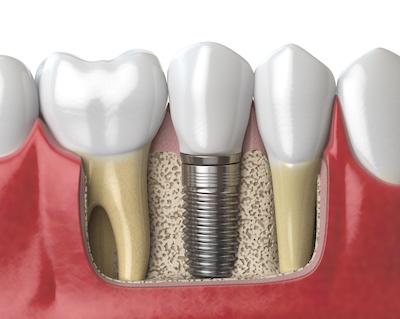
Do you struggle with the pain and limitations of missing teeth? Have you recently experienced tooth loss and want to understand your options? There are numerous solutions, but dental implants stand out as the top choice among dentists and patients. One reason for their popularity is they are a permanent solution that mimics a natural tooth in appearance, form, and function.
If you are considering replacing missing teeth, it’s worth your while to take a look at our dental implants guide. In this blog, you’ll find comprehensive information to help you understand what they are, the benefits they offer, and whether they fit your smile goals.
What Are Dental Implants?
An implant is an artificial tooth root made of titanium, the same material used in medicine for decades for joint replacements. Because titanium is biocompatible, the body easily accepts it after the implant is surgically placed in the jawbone. Bone and tissue in the jaw fuse with the post, becoming a permanent part of your dental anatomy, just like a natural tooth root.
To help you understand how a dental implant works to improve your smile and oral health, it’s important to understand the components involved. There are three parts to a dental implant that work together to restore appearance, comfort, and chewing function:
- Implant Post — A replacement tooth root is placed in the jawbone and allowed to heal over several months.
- Implant Abutment — An attachment secured to the implant post to support a dental restoration
- Implant Restoration — A crown, bridge, or denture that restores appearance and comfortable chewing.
Benefits of Dental Implants
If you’re weighing the pros and cons of different types of tooth replacement, consider the many benefits dental implants offer:
- Lasts a Lifetime — Unlike dentures or bridges, implants are designed to last a lifetime with proper care.
- Improves Functionality — Allow patients to eat, speak, and chew comfortably and easily, just like natural teeth.
- Enhances Aesthetics — Implant teeth look and feel like natural teeth and are designed to blend seamlessly with the smile.
- Prevents Bone Loss — Implants stimulate the jawbone, preventing bone loss commonly occurring with missing teeth.
Who Is a Candidate for Dental Implants?
While anyone with missing teeth is a potential candidate, several requirements determine implant eligibility.
- Healthy gums free of periodontal disease are essential to long-term implant success
- Sufficient jawbone density determines whether there’s enough mass to hold the implant post securely.
- Medical conditions may also be a consideration. Diabetes may be an issue as it slows healing, which can lead to implant failure. This doesn’t mean a person with diabetes isn’t a good candidate; it just means that careful monitoring and consideration are needed.
- A commitment to oral hygiene after placement can make the difference between implant failure and success.
- Smoking, which can reduce blood flow to the gums and jawbone, can make it harder for the implant to fuse with the jawbone and delay the recovery process.
Before your dentist can consider you for dental implants, they will use advanced technology and perform a thorough examination to determine if this tooth replacement is right for you.
Types of Dental Implants
 Based on your dentist’s evaluation, they will recommend the most appropriate type of implant for your needs. The types of dental implants include the following:
Based on your dentist’s evaluation, they will recommend the most appropriate type of implant for your needs. The types of dental implants include the following:
- Endosteal Implants
This type of implant is the one most people are familiar with. An endosteal implant is surgically placed directly into the jawbone to act as artificial tooth roots. They are ideal for patients with a strong, healthy jawbone. - Subperiosteal Implants
For those lacking sufficient jawbone density, subperiosteal implants are placed under the gum but on or above the jawbone rather than within it. This type is less common today, as advancements in bone grafting have made endosteal implants possible for more people. - Zygomatic Implants
Zygomatic implants are less common and used for patients with severe bone loss in the upper jaw. This type involves a more complex procedure and is often performed as a last resort when other types of implants or bone grafts are not viable options.
These are the primary types of implants, each designed to address different patient needs depending on bone structure, dental health, and overall suitability for surgery.
The Dental Implant Procedure
Initial Consultation and Planning
The dental implant process begins with an initial consultation. During this visit, your dentist or oral surgeon will assess your dental health, review your medical history, and determine whether you are a suitable candidate for implants. This assessment typically includes x-rays or 3-D imaging to examine the condition of your jawbone and surrounding structures.
If there are any existing oral health issues, such as gum disease, these will need to be treated before proceeding. Additionally, your dentist will discuss your goals, answer any questions, and outline a treatment plan that fits your specific needs. In some cases, preparatory work such as tooth extractions or bone grafting may be necessary before the implant placement.
Step-by-Step Dental Implant Process
Your dental team will walk you through the process, and here are the steps you can expect:
- Bone Grafting (if necessary) — Your dentist may recommend bone grafting if you don’t have enough healthy jawbone to support an implant. This involves placing bone material—yours or from a donor—to rebuild that part of the jaw. After grafting, the jaw will need time to heal and regenerate, which can take several months.
- Implant Surgery — The first major step is implant placement. During this minor surgical procedure, the dentist expertly inserts the titanium post into the jawbone under local anesthesia.
- Osseointegration — After placement, the implant fuses with the bone and tissue around it to create a strong and stable foundation for the replacement tooth. This process is called osseointegration and typically takes 3–6 months. During healing, the dentist will place temporary crowns or dentures to maintain your smile’s appearance and functionality.
- Abutment Placement — The next step is placing an abutment. This small connector piece is attached to the top of the implant post and links the implant to the replacement tooth.
- Crown Placement—The final step is removing the temporary and attaching the custom-made crown, which serves as the replacement tooth. For multiple tooth replacements, your dentist may recommend an implant bridge or denture.
Dental Implant Care and Maintenance
Dental implants can last a lifetime but require a commitment to proper care. Like natural teeth, daily oral hygiene is essential to prevent plaque buildup and gum disease.
Brush at least twice daily and floss once with a special interdental brush to clean around the implant. Maintain regular dental checkups and cleanings so your dental team can monitor the health of the implant and surrounding gums.
Avoid habits that can damage the implant, such as chewing on ice, hard candies, or non-food objects. If you grind your teeth, wear a nightguard to protect the implant.
Call Us with Your Dental Implant Questions
Dr. Bruce Matthews and his experienced team of dentists are trained in dental implantology, so you can expect the highest-quality treatment and results. We understand that choosing dental implants is a major decision, and we would be honored to be a part of your journey to a healthier smile.
If you would like to schedule a consultation appointment to learn more about dental implants in Wilmington or discuss all our tooth replacement options, please call us at (302) 475-9220.
